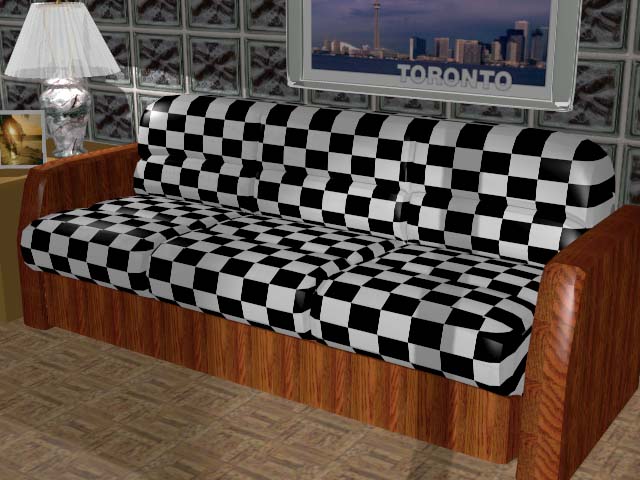| You are here: Home » Products » PolyTrans-for-CINEMA 4D |
| Couch and Lamp |
This scene was created to demonstrate how a 2d scanned bitmapped texture could be easily wrapped around the curved surfaces of a couch.
The couch itself was imported into the NuGraf software as a Lightwave model from the LightROM-3 CDROM. The polygon picking mechanism and the "move polygons to new object" command of NuGraf was then used to break apart the model into separate pieces. At this stage the interactive "texture projection" routines were used to assign texture coordinates to the various pieces of the model. The assignments are as follows:
- Front-lower kicker = Planar projection from the front
- Front of cushions = Cylindrical projection
- Top of cushions = Planar projection from the top
- Vertical cushions = Planar projection from the front
- Arm rests = Box projection
The floor, wall and couch are covered with 2d scanned bitmap textures. The base of the lamp uses 2 layered textures; the first is a scanned marble texture and the second is a 2d bump map texture of white circles that produces a depressed dent effect. The texture map used on the wall is also used to bump map the wall; the effect is to give the wall texture some "depth" at the expense of increased rendering time.
Four light sources illuminate the scene:
- A point light source is positioned just inside the lamp shade. This light source uses 6 shadow maps.
- A low intensity directional light shines from above to provide fill illumination.
- A spot light shines from just behide the camera towards the right side of the couch. This was added to simulate sun light shining through a window and to give a nice illumination contrast to the harsh illumination coming from the point light near the lamp. Note that a "cross" object was placed in front of the spot light to simulate a window frame (the shadow from the cross can be seen on the couch). This light source uses one shadow map.
- A white ambient light source is used to fill in the dark areas.
All textures use MIPmap filtering to eliminate texture filtering artifacts.


